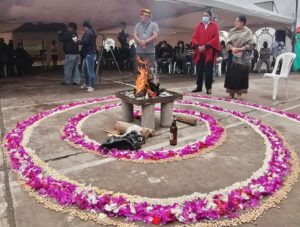by Tristan Partridge
The community meeting house in San Isidro, in Ecuador’s central Andes, had been specially decorated for an important occasion. On the outside wall hung a large rainbow banner celebrating the regional Indigenous organization, MICC (Movimiento Indígena y Campesino de Cotopaxi). On the ground outside, an open fire crackled at the center of a ceremonial spiral of bright purple flowers. The occasion: a meeting with leaders from the national Indigenous Movement, CONAIE (Confederación de Nacionalidades Indígenas del Ecuador).

On the agenda: strategies for how Indigenous communities across the country can collaborate to protect sacred landscapes and defend collective rights – work that people in San Isidro have been engaged with for a long time. Two days later, on Friday 20 November, they celebrated a milestone in their campaign and an important victory for Indigenous environmental activism nationwide.
Following years of organizing and campaigning, the Regional Director of the national Ministry for the Environment & Water confirmed the community’s request: land that they own collectively is now formally recognized as a national Protected Hydrological Area (APH). This not only offers new levels of legal recourse, it also creates a model for other communities to follow — in the much-needed protection of unique ecosystems.
San Isidro residents have worked tirelessly to conserve an area covering 1071 hectares of the high-altitude páramo hills. A wetland ecosystem found only in the moorlands of the northern Andes, the páramo is of great importance — both locally within the hydrological cycle and globally in terms of climate change. By absorbing rainfall, filtering the water and then gradually releasing it into countless streams and rivers, páramo lands are estimated to be the origin for 85% of the water used across Ecuador for drinking, hydroelectric power systems, and agricultural irrigation. Recent studies have also confirmed the global impacts of a healthy páramo — acting as a carbon sink and thus helping to regulate broader climate patterns.

In February of this year, the APH campaign cleared its first major institutional hurdle when the request was formally accepted by the national Ministry for Water (Senagua). At that time, community president Porfirio Allauca emphasized how the benefits of caring for the páramo extend beyond San Isidro itself. He noted that the Cuchiwasi and Nagsiche rivers are both ‘born’ in these hills — and that these rivers are vital for supplying water both to the local town of Pujilií and across the region.
Nationwide, the páramo as a whole is a primary source of drinking water for millions of Ecuadorians. Yet many areas of the páramo are currently under threat — both in Ecuador and across the border in Colombia. The threats take many forms, including mining interests, industrial forestry, and overgrazing. This has generated a number of environmental conflicts, including in defense of the Quimsacocha páramo in Azuay province — where the Chinese firm Ecuagoldmining South America S.A has plans for its Río Blanco project and the Canadian company INV Metals (previously IAMGOLD) has plans to develop the huge Loma Larga gold-silver-copper mining project. At the same time, interest in protecting the páramo is growing, including among NGOs and international research institutions. On the ground, the hope is that wherever the future of the páramo is at risk, communities can follow the lead of San Isidro and organize to acquire APH recognition — gaining another tool to use in the defense of these territories.

The San Isidro páramo is known by its Kichwa name, Chilca Tingo Chaupi Urku, and is located some 20km uphill from the village itself, in Cotopaxi province. Following land reform in the 1960s and the formal abolition of the ‘hacienda’ system of Indigenous enslavement, this land was granted as patrimony to the families of 34 ‘huasipungueros’ (indentured/forced laborers on the hacienda estate) who were part of the ancestral community of Juigua San Isidro. These were people who had recently gained the freedom to live and work outside the hacienda and who had to fight fiercely in order to acquire land rights for their community. The páramo has thus for a long time been a symbol of solidarity. Today, it is also a site of collectivity and cooperation. In recent decades, community conservation work in the páramo has involved planting native trees and protecting endemic flora, in addition to pursuing the legal campaign for ‘protected’ status.
Many in San Isidro also see the páramo as a living being — as ‘our refuge’ and ‘our sister.’ The páramo is symbolically a source of strength and also, very tangibly, a source of life. As María Rojas, a leader within San Isidro, told local news, “If we don’t have the páramo, we don’t have water… and without water, there’s no life. Without water, there are no crops; there’s just nothing. Without water, we would die.”
Yet, even while its vital ecological importance is gaining wider recognition, the páramo is still seen by a powerful minority as a source of natural resources ready for exploitation. For the good of communities like San Isidro and, indeed, for the sake of the world as a whole, there is a clear need for a broad environmental movement that foregrounds páramo protection. All available strategies will need to be used — including the legal defense of its APH status as a legally protected hydrological area— if society at large is to heed, and act on, the words of María Rojas and others living on the frontlines. To be successful, páramo protection will need to be led by the Indigenous and campesino communities who share the richest histories and everyday entanglements with these unique lands. San Isidro’s recent achievement is a crucial step ensuring the páramo continues to thrive for generations to come.
Tristan Partridge is a social anthropologist and Research Fellow in the Institute for Social, Behavioral and Economic Research at the University of California, Santa Barbara. His research addresses indigenous rights, collective action, and environmental justice.
